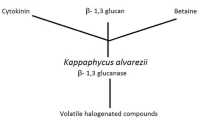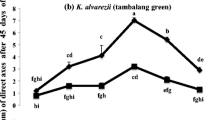Abstract
Gracilaria spp. (agarophytes) are cultivated by Panamanian communities to use directly as food and as important components of traditional medicines and remedies. These uses are part of the traditional culture of both the Guna Indians and the Afro-Antillean communities. One driving force to better understand the biology of the various species of Gracilaria is their additional, commercial uses based on the agars they produce. In this study, we evaluated the effects of two commercial, soluble extract powders of the temperate, brown seaweed Ascophyllum nodosum (i.e., Ascophyllum marine plant extract powder—AMPEP), and one which had a boosted potassium level (designated as AMPEP K+). Each was evaluated for any micropropagation effects on the tropical red alga, Gracilaria blodgettii, in three independent experiments each of which lasted 45 days (the normal grow-out period). The phyco-stimulatory extracts were tested with and without association with standard plant growth regulators which are commonly used in micropropagation practices for higher plants. Growth was measured as a function of increased fresh weight and the number of newly emergent lateral shoots. This study demonstrated that vegetative propagules of G. blodgettii treated with AMPEP at 0.1 mg L−1 provided significant contributions to the successful and sustainable supply of vegetative propagules (“seedstock”). We suggest that the costs and quality of seedstock production can be significantly reduced over traditional methods, thereby contributing to the establishment of much-needed, viable marine farming practices in the Panamanian Caribbean.

Similar content being viewed by others
References
Abbott IA, Norris J (1985) Taxonomy of economy seaweeds with reference to some Pacific and Caribbean species. California Sea Grant College Program University of California, La Jolla, California, Report No. T-CS GCP-011, pp 47–61
Ali MKM, Sani MZB, Hi KK, Yasir SM, Keon KH, Critchley AT, Hurtado AQ (2018a) The comparative efficiency of a brown algal derived biostimulant extract (AMPEP), with and without supplemented PGRs: the induction of direct, axis shoots as applied to the propagation of vegetative seedlings for the successful mass cultivation of three commercial strains of Kappaphycus in Sabah, Malaysia. J Appl Phycol 30:1913–1919
Ali MKM, Yasir SM, Critchley AT, Hurtado AQ (2018b) Impacts of Ascophyllum marine plant extract powder (AMPEP) on the growth, incidence of the endophyte Neosiphonia apiculata and associated carrageenan quality of three commercial cultivars of Kappaphycus. J Appl Phycol 30:1185–1195
Ali MKM, Critchley AT, Hurtado AQ (2020) The impacts of AMPEP K+ (Ascophyllum marine plant extract, enhanced with potassium) on the growth rate, carrageenan quality, and percentage incidence of the damaging epiphyte Neosiphonia apiculata on four strains of the commercially important carrageenophyte Kappaphycus, as developed by micropropagation techniques. J Appl Phycol. https://doi.org/10.1007/s10811-020-02117-0
Batista G (1992) Gracilaria spp. sea farm on the Atlantic Coast of Panama in connection with establishment of a nature reserve with and economic purpose. MS thesis, University of California, Berkeley, 232 pp
Batista G, Connor J (1990) Native uses of seaweeds in the Republic of Panama. Annotated Bibliography of the Seaweeds used for food in the West Indies. OECS Fisheries Report No 3.7-8. Caribbean Natural Resource Institute (CANARI), St. Lucia
Brooks B (2015) A rapid assessment of the marine plant ecosystems at the Caribbean entrance of the Panama Canal. Plant Press New Ser 18:12–13
Byrne K, Zuccarello G, West J, Liao ML, Kraft G (2006) Gracilaria species (Gracilariaceae, Rhodophyta) from southeastern Australia, including a new species, Gracilaria perplexa sp. nov.: morphology, molecular relationships and agar content. Phycol Res 50:295–311
Connor JL (1984) Seasonal changes in an algal community of a tropical fringing reef in Panama. PhD Thesis, University of California, Berkeley. pp. 1–82
Cubit J (1994) Global climate change and importance of tidal flat ecosystems in the Caribbean and Gulf of Mexico. Bull Mar Sci 54:1073–1074
Cubit J, Connor JL (1993) Effects of the 1986 Bahía Las Minas oil spill on reef flat sessile biota, algal-turf infauna, and sea urchins. In: Keller BD, Jackson JBC (eds) Long-term Assessment of the oil spill at Bahía Las Minas, Panama. Synthesis Report. Volume II: Technical Report, Part 1: 131–242,. OCS Study MMS 93–0048. U.S. Department of the Interior, Minerals Management Services, Gulf of Mexico OCS Region, New Orleans. https://doi.org/10.7901/2169-3358-1993-1-329 (accessed April 15, 2020)
Cubit J, Thompson R, Caffey H, Windsor D (1988) Hydrographic and meteorological studies of a Caribbean fringing reef at Punta Galeta, Panama: hourly and daily variations for 1977-1985. Smithson Contrib Mar Sci 32:1–220
De Robertis E, De Robertis EM Jr (1980) Cell and molecular biology. Saunders College, Philadelphia
Doty MS (1986) The production and use of Eucheuma. In Doty MS, JF Caddy & B Santelices. Case studies of seven commercial seaweeds resources. FAO Fish Tech Pap 281:123–164
FAO (2018) The global status of seaweed production, trade and utilization. Globefish Research Programme, Rome, p 124
Fredericq S, Norris JN (1992) Studies on cylindrical species of western Atlantic Gracilaria (Gracilariales, Rhodophyta): G. cylindrica Børgesen and G. blodgettii Harvey. Tax Econ Seaweeds 3:211–231
Gurgel CFD, Fredericq S (2004) Systematics of the Gracilariaceae (Gracilariales, Rhodophyta): a critical assessment based on rbcl sequence analyses. J Phycol 40:138–159
Hay ME (1980) Algal ecology on a Caribbean Fringing Reef. PhD Thesis, University of California, Irvine
Hayashi L, Yokoya NS, Kikuchi DM, Oliveira EC (2007) Callus induction and micropropagation improved by colchicine and phytoregulators in Kappaphycus alvarezii (Rhodophyta, Solieriaceae) J. Appl Phycol 20:653–659
Hurtado AQ, Critchley AT (2018) A review of multiple biostimulant and bioeffector benefits of AMPEP, an extract of the brown alga Ascophyllum nodosum, as applied to the enhanced cultivation and micropropagation of the commercially important red algal carrageenophyte Kappaphycus alvarezii and its selected cultivars. J Appl Phycol 30:2859–2873
Hurtado AQ, Yunque DA, Tibubos KT, Critchley AT (2008) Use of Acadian marine plant extract powder from Ascophyllum nodosum in tissue culture of Kappaphycus varieties. J Appl Phycol 21:633–639
Hurtado AQ, Yunque DA, Tibubos K, Critchley AT (2009) Use of Acadian marine plant extract powder from Ascophyllum nodosum in tissue culture of Kappaphycus varieties. J Appl Phycol 21:633–645. https://doi.org/10.1007/s10811-008-9395-4
Hurtado AQ, Neish I, Critchley AT (2019) Phyconomy: the extensive cultivation of seaweeds, their sustainability and economic value, with particular reference to important lessons to be learned and transferred from the practice of eucheumatoid farming. Phycologia 58:472–483
Loureiro RR, Reis RP, Berrogain FD, Critchley AT (2014) Effects of a commercial extract of the brown alga Ascophyllum nodosum on the biomass production of Kappaphycus alvarezii (Doty) Doty ex P.C. Silva and its carrageenan yield and gel quality cultivated in Brazil. J Appl Phycol 26:763–768
Santos R, Melo RA (2018) Global shortage of technical agars: back to basics (resource management). J Appl Phycol 30:2463–2473
Souza JMC, Castro JZ, Critchley AT, Yokoya NS (2019) Physiological responses of the red algae Gracilaria caudata (Gracilariales) and Laurencia catarinensis (Ceramiales) following treatment with a commercial extract of the brown alga Ascophyllum nodosum (AMPEP). J Appl Phycol 31:1883–1888
Tibubos KR, Hurtado AQ, Critchley AT (2017) Direct formation of axes in new plantlets of Kappaphycus alvarezii (Doty) Doty, as influenced by the use of AMPEP K+, spindle inhibitors, and plant growth hormones. J Appl Phycol 29:2345–2349
Ulloque CE (2019) Estudio estadístico del crecimiento de explantos de algas marinas en cultivos in-vitro. M Eng Thesis, Universitat Politècnica de València
Umanzor S, Shin S, Marty-Rivera M, Augyte S, Yarish C, Kim JK (2019) Preliminary assessment on the effects of the commercial seaweed extract, AMPEP, on growth and thermal tolerance of the kelp Saccharina spp. from the Northwest Atlantic. J Appl Phycol 31:3823–3829
Vega GB (2004a) A commercial feasibility of Gracilaria domingensis farming using protected systems of planting on the Caribbean coastal zone, Panama. Scientia 19:55–66
Vega GB (2004b) A commercial feasibility of Gracilaria domingensis farming using unprotected planting systems on the Caribbean coastal zone, Panama. Scientia 19:23–53
Vega GB (2009) Cultivo Ecosostenible de Kappaphycus alvarezii en Panamá. PhD. Thesis, Universidad de las Palmas de Gran Canaria,
Vega GB, Yee R (2006) Use of the seaweed’s resources on the Caribbean coastline, Province of colon, Panama and its potential economic possibilities. Seaweed Resources of Panama Chapter 3. In: Critchley, A., M. Ohno & D.B. Largo (Eds) World Seaweeds Resources
Vega GB, Shields C, Contreras A, González J (2002) Granjas Experimentales de Gracilaria sp y Eucheuma cotoni en el Caribe Panameño. VI Congreso Latinoamericano de Ficología y IV Reunión Iberoamericana de Ficología; Ponce, Puerto Rico. Sociedad de Ficología Latinoamericana y del Caribe y Pontificia Universidad Católica de Puerto Rico (Eds) pp O 26
Vega GB, Berguido C, Alveo D (2006) Food and medical uses of marine algae by Kuna Indians on the Caribbean, Panama. Seaweed Resources of Panama. In: A.T. Critchley, A., M. Ohno & D.B. Largo (Eds) World Seaweeds Resources
Vega GB, Ceballos J, Anzalone A, Digman MA, Gratton E (2017) A laser-scanning confocal microscopy study of carrageenan in red algae from seaweed farms near the Caribbean entrance of the Panama Canal. J Appl Phycol 29:495–508
Yunque DAT, Tibubos KR, Hurtado AQ, Critchley AT (2011) Optimization of culture conditions for tissue culture production of young plantlets of carrageenophyte Kappaphycus. J Appl Phycol 23:433–438
Acknowledgments
The transportation to visit the seaweed farms and samples of the algae were donated by Gracilarias of Panama S.A. and Sea Farms. Thanks go to Amanda Burgueño of Global SLI for her advice in this study in following a good farm practice. Dr. María Rosa Alcover Arándiga and Dr. Vicente Chirivella González, Polytechnic University of Valencia, Spain are acknowledged for their guidelines. The authors wish to thank Ms. Jeimy Gondola for her support in the laboratory and Petro American Terminal S.A. for facilitating the areas near the ports that allowed for the installation of the algal cultivation tanks. The samples of AMPEP and AMPEP K+ were a donation from Acadian Seaplants. The authors would like to thank the journal reviewers for constructive feedback in the production of this manuscript.
Funding
The Smithsonian Institute in Washington, DC, and the Smithsonian Tropical Research Institute in Panama under the research “Eco-sustainable culture of seaweed and its applications” and Messrs. Samuel and Guillermo Liberman, of Global SLI, undisputed patrons of scientific research in Panama, provided generous funding for this work.
Author information
Authors and Affiliations
Corresponding author
Additional information
Publisher’s note
Springer Nature remains neutral with regard to jurisdictional claims in published maps and institutional affiliations.
Rights and permissions
About this article
Cite this article
de Vega, G.B., Ulloque N, C.E., Hurtado, A.Q. et al. On the efficacy of an Ascophyllum-based, soluble extract in association with standard plant growth regulators on the micropropagation of the agarophyte, Gracilaria blodgettii, from seaweed farms located at the northern entrance of the Panama Canal. J Appl Phycol 32, 3211–3217 (2020). https://doi.org/10.1007/s10811-020-02168-3
Received:
Revised:
Accepted:
Published:
Issue Date:
DOI: https://doi.org/10.1007/s10811-020-02168-3




